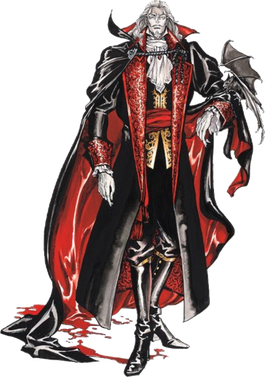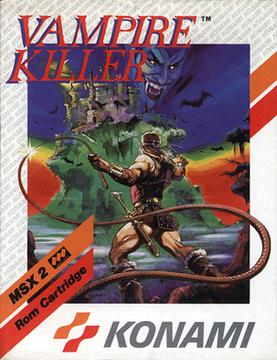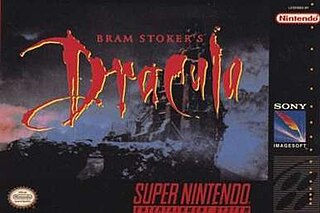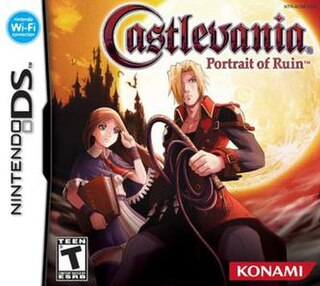
Castlevania, known in Japan as Akumajō Dracula, is a gothic horror action-adventure video game series and media franchise about Dracula, created and developed by Konami. It has been released on various platforms, from early systems to modern consoles, as well as handheld devices such as mobile phones. The franchise has expanded into several spin-off video games and other media, including comic books and an animated television series.

Adrian Fahrenheit Țepeș, better known as Alucard, is a character in Konami's Castlevania series of video games. His first appearance in the series was in the 1989 game Castlevania III: Dracula's Curse, but he is best known for his role in the critically acclaimed Castlevania: Symphony of the Night, released in 1997. His design in Symphony of the Night was created by Ayami Kojima, marking her first contribution to the Castlevania franchise.

Castlevania: Symphony of the Night is an action role-playing game developed and published by Konami for the PlayStation and Sega Saturn. It was directed and produced by Toru Hagihara, with Koji Igarashi acting as assistant director. It is a direct sequel to Castlevania: Rondo of Blood, taking place four years later. It features Dracula's dhampir son Alucard as the protagonist, rising from his slumber to explore Dracula's castle which resurfaced after Richter Belmont vanished. Its design marks a break from previous entries in the series, re-introducing the exploration, nonlinear level design, and role-playing elements first experimented with in Castlevania II: Simon's Quest.

Castlevania: Aria of Sorrow is a 2003 Metroidvania video game developed and published by Konami. It is the third Castlevania game for the Game Boy Advance. Producer Koji Igarashi, who had led the production teams for previous Castlevania games, led Aria of Sorrow's development as well. Michiru Yamane returned to compose the music alongside Takashi Yoshida and Soshiro Hokkai. Director Junichi Murakami was new to the Castlevania series.

Dracula Vlad Țepeș or simply known as Dracula, real name Mathias Cronqvist, is a fictional character from the Castlevania video game series. A vampire and a sorcerer, he is the main antagonist of the series and the final boss of almost every installment. He is the overall protagonist in the rebooted Castlevania trilogy Lords of Shadow—though he takes on his classical antagonistic role in the game Mirror of Fate—where his origin is heavily altered, as he is reimagined as being part of a holy order who eventually falls from grace and becomes the vampire Dracula, making him the king and ruler of darkness.

Castlevania: Circle of the Moon, titled Castlevania in PAL regions, is a platform video game created by Konami for the Game Boy Advance. Published as a launch title in 2001, Circle of the Moon is part of Konami's Castlevania video game series, the premise of which centers on the eternal conflict between the vampire hunters of the Belmont clan and the vampire Dracula. The game sold one million copies worldwide and was acclaimed by critics. The events of its plot were retconned by former Castlevania producer Koji Igarashi, a move which was met with some criticism.

Vampire Killer, known in Japan as Akumajō Dracula, is a platform video game developed and published by Konami for the MSX2 in 1986. It is a parallel version of the original Castlevania, which debuted a month earlier for the Famicom Disk System under the same Japanese title. However, the MSX2 version was localized first in Europe and was published without the Castlevania branding that the franchise would start using abroad in 1987 when the NES version was released in North America. It was released on the Wii U's Virtual Console on December 17, 2014 in Japan.

Castlevania: Dawn of Sorrow is a 2005 action-adventure game developed and published by Konami. It is part of Konami's Castlevania video game series and the first Castlevania game released on the Nintendo DS. The game is the sequel to Castlevania: Aria of Sorrow and incorporates many elements from its predecessor. Dawn of Sorrow was commercially successful. It sold more than 15,000 units in its first week in Japan and 164,000 units in the United States during the three months after its initial release.

Castlevania: Curse of Darkness is an action-adventure game, part of the Castlevania franchise. It is the second 3D Castlevania title developed by Konami Computer Entertainment Tokyo, released in 2005 following Castlevania: Lament of Innocence and was available for PlayStation 2 and Xbox in all regions except Japan, where the game was only available on PlayStation 2. Curse of Darkness received mixed reviews, common praise was directed towards its combat system, music, content, and replay value, while criticism fell towards its story, characters, repetitive level-design and gameplay.

Castlevania, also referred to as Castlevania 64, is a 1999 action-adventure video game developed by Konami's Kobe branch for the Nintendo 64. An expanded version of the game, Castlevania: Legacy of Darkness, was released later in the same year.

Castlevania: Legacy of Darkness is an action-adventure platforming video game, that was developed and published by Konami for the Nintendo 64. It was released in 1999 and is a prequel and expanded version of Castlevania, also released on the Nintendo 64 earlier the same year; it contains a remake of the original game with improved graphics, added villains, and alternate versions of some levels.

Castlevania Legends is the third Castlevania title released for the original Game Boy. It was released in Japan on November 27, 1997 and in Europe and North America on March 11, 1998.

Super Castlevania IV is a platform video game developed and published by Konami for the Super Nintendo Entertainment System. It has been re-released multiple times, including for the Super NES Classic Edition.

Castlevania: Bloodlines, known in Japan as Vampire Killer and in PAL regions as Castlevania: The New Generation, is a platform game developed and published by Konami in 1994 for the Sega Genesis, part of the Castlevania series. A vampire named Elizabeth Bartley is orchestrating the beginning of World War I as a sacrificial war to bring her uncle, Dracula, back to life. Players take on the role of Quincey Morris' son, John, and his friend Eric Lecarde to take up the fight against evil.

Bram Stoker's Dracula is a 1993 video game released for the Mega Drive/Genesis, Nintendo Entertainment System, Super NES, Game Boy, Master System, Sega CD, Game Gear, MS-DOS and Amiga games consoles. Based on the 1992 film Bram Stoker's Dracula which in turn is based on the 1897 novel Dracula by Bram Stoker, each version of the game was an action-platformer except the Sega CD and Amiga versions which were beat 'em ups, and the DOS version which was a first-person shooter. The Amiga version was released in 1994 for North America and Europe. A CD-ROM version for DOS was released in 1995.

Castlevania: Portrait of Ruin is a platform-adventure game developed and published by Konami. The game was released on November 16, 2006 in Japan, and in North America on December 5, 2006 for the Nintendo DS handheld game console. Portrait of Ruin is the first Castlevania to feature a cooperative multiplayer gameplay mode and the first handheld Castlevania to have English voice-overs, outside of its original Japanese release.

Castlevania, known in Japan as Akumajō Dracula, is a platform game developed and published by Konami for the Family Computer Disk System video game console in Japan in September 1986. It was ported to cartridge format and released in North America for the Nintendo Entertainment System (NES) in May 1987 and in Europe in 1988. It was also re-issued for the Family Computer in cartridge format in 1993. It is the first game in Konami's Castlevania video game series.

Bloodstained: Curse of the Moon is a 2018 platform game developed and published by Inti Creates. It is a companion title to developer ArtPlay's 2019 game Bloodstained: Ritual of the Night and was conceived to fulfill the promise for a retro-style accompaniment to Ritual of the Night after its Kickstarter campaign exceeded crowdfunding goals. Curse of the Moon follows Zangetsu, a cursed swordsman hunting down demons for revenge, as well as three other playable characters named Miriam, Alfred and Gebel. It features an 8-bit aesthetic and gameplay style similar to Castlevania games on the Nintendo Entertainment System (NES), particularly Castlevania III: Dracula's Curse (1989).

Dracula's Castle is a setting in the video game Castlevania: Symphony of the Night (1997), which was designed by Koji Igarashi. Players control the protagonist Alucard as they explore the castle, which was based on the traditional depiction of Castle Dracula from the horror novel by Bram Stoker and related media, and is one of numerous incarnations in the Castlevania series. Upon defeating Shaft, a minion of Dracula, players are able to enter the Inverted Castle, an upside down version of the original castle that was included because the designers wanted to add more content without having to create new assets. The Inverted Castle served as inspiration for multiple games, such as 2014's Strider and Igarashi's Bloodstained: Ritual of the Night.



















